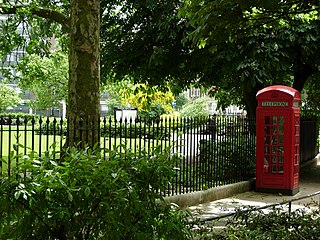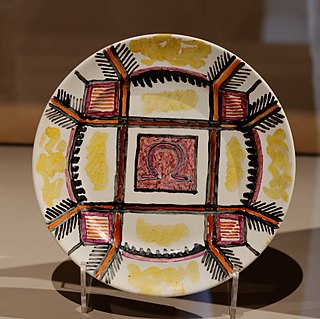
Roger Eliot Fry was an English painter and critic, and a member of the Bloomsbury Group. Establishing his reputation as a scholar of the Old Masters, he became an advocate of more recent developments in French painting, to which he gave the name Post-Impressionism. He was the first figure to raise public awareness of modern art in Britain, and emphasised the formal properties of paintings over the "associated ideas" conjured in the viewer by their representational content. He was described by the art historian Kenneth Clark as "incomparably the greatest influence on taste since Ruskin ...In so far as taste can be changed by one man, it was changed by Roger Fry". The taste Fry influenced was primarily that of the Anglophone world, and his success lay largely in alerting an educated public to a compelling version of recent artistic developments of the Parisian avant-garde.

Fitzrovia is a district of central London, England, near the West End. The eastern part of area is in the London Borough of Camden, and the western in the City of Westminster. It has its roots in the Manor of Tottenham Court, and was urbanised in the 18th century. Its name was coined in the late 1930s by Tom Driberg.

Russell Square is a large garden square in Bloomsbury, in the London Borough of Camden, built predominantly by the firm of James Burton. It is near the University of London's main buildings and the British Museum. Almost exactly square, to the north is Woburn Place and to the south-east is Southampton Row. Russell Square tube station sits to the north-east.

Brunswick Square is a 3-acre (1.2 ha) public garden and ancillary streets along two of its sides in Bloomsbury, in the London Borough of Camden. It is overlooked by the School of Pharmacy and the Foundling Museum to the north; the Brunswick Centre to the west; and International Hall to the south. East is an enclosed area of playgrounds with further trees, Coram's Fields, associated with charity Coram Family which is just over double its size; next to that area Brunswick Square is mirrored, symmetrically by Mecklenburgh Square, likewise of 3 acres including roads. The squares are named after contemporary Queen consorts.

Gordon Square is a public park square in Bloomsbury, London, England. It is part of the Bedford Estate and was designed as one of a pair with the nearby Tavistock Square. It is owned by the University of London.

The Omega Workshops Ltd. was a design enterprise founded by members of the Bloomsbury Group and established in July 1913. It was located at 33 Fitzroy Square in London, and was founded with the intention of providing graphic expression to the essence of the Bloomsbury ethos. The Workshops were also closely associated with the Hogarth Press and the artist and critic Roger Fry, who was the principal figure behind the project, believed that artists could design, produce and sell their own works, and that writers could also be their own printers and publishers. The Directors of the firm were Fry, Duncan Grant and Vanessa Bell.

Bedford Square is a garden square in the Bloomsbury district of the Borough of Camden in London, England.

Belgrave Square is a large 19th-century garden square in London. It is the centrepiece of Belgravia, and its architecture resembles the original scheme of property contractor Thomas Cubitt who engaged George Basevi for all of the terraces for the 2nd Earl Grosvenor, later the 1st Marquess of Westminster, in the 1820s. Most of the houses were occupied by 1840. The square takes its name from one of the Duke of Westminster's subsidiary titles, Viscount Belgrave. The village and former manor house of Belgrave, Cheshire, were among the rural landholdings associated with the main home and gardens of the senior branch of the family, Eaton Hall. Today, many embassies occupy buildings on all four sides.

Richmond Green is a recreation area near the centre of Richmond, a town of about 20,000 inhabitants situated in south-west London. Owned by the Crown Estate, it is leased to the London Borough of Richmond upon Thames. The Green, which has been described as "one of the most beautiful urban greens surviving anywhere in England", is roughly square in shape and its open grassland, framed with broadleaf trees, extends to roughly twelve acres. On the north-east side there is also a smaller open space called Little Green. Richmond Green and Little Green are overlooked by a mixture of period townhouses, historic buildings and municipal and commercial establishments including the Richmond Lending Library and Richmond Theatre.

Fitzroy Square is a Georgian square in London. It is the only one in the central London area known as Fitzrovia. The square is one of the area's main features, this once led to the surrounding district to be known as Fitzroy Square or Fitzroy Town and latterly as Fitzrovia, though the nearby Fitzroy Tavern is thought to have had as much influence on the name as Fitzroy Square.

Brunswick Town is an area in Hove, in the city of Brighton and Hove, England. It is best known for the Regency architecture of the Brunswick estate.

As of February 2001, there were 1,124 listed buildings with Grade II status in the English city of Brighton and Hove. The total at 2009 was similar. The city, on the English Channel coast approximately 52 miles (84 km) south of London, was formed as a unitary authority in 1997 by the merger of the neighbouring towns of Brighton and Hove. Queen Elizabeth II granted city status in 2000.

Endell Street, originally known as Belton Street, is a street in London's West End that runs from High Holborn in the north to Long Acre and Bow Street, Covent Garden, in the south. A long tall narrow building on the west side is an 1840s-built public house, the Cross Keys, Covent Garden.

Chenies Street is a street in Bloomsbury, London, that runs between Tottenham Court Road and Gower Street. It is the location of a number of notable buildings such as Minerva House, the Drill Hall, and a memorial to The Rangers, 12th County of London Regiment. North Crescent starts and ends on the northern side of Chenies Street.

Cartwright Gardens is a crescent shaped park and street located in Bloomsbury, London.

UCL Observatory at Mill Hill in London is an astronomical teaching observatory. It is part of the Department of Physics and Astronomy at University College London.

Lloyd Square, a garden square in Clerkenwell, central London, It consists of Grade II Listed houses making up a square of unique and noted character in central London. Its nearest tube stations are Kings Cross, Russell Square, Farringdon, Angel and Chancery Lane. The square has mature trees, flowers, beds and shrubs and is lined by neat hedges and formal railings, which are listed.

As of February 2001, there were 1,124 listed buildings with Grade II status in the English city of Brighton and Hove. The total at 2009 was similar. The city, on the English Channel coast approximately 52 miles (84 km) south of London, was formed as a unitary authority in 1997 by the merger of the neighbouring towns of Brighton and Hove. Queen Elizabeth II granted city status in 2000.

As of February 2001, there were 1,124 listed buildings with Grade II status in the English city of Brighton and Hove. The total at 2009 was similar. The city, on the English Channel coast approximately 52 miles (84 km) south of London, was formed as a unitary authority in 1997 by the merger of the neighbouring towns of Brighton and Hove. Queen Elizabeth II granted city status in 2000.

The London Foot Hospital was founded in 1913 as The Pedic Clinic for Gratuitous Treatment of the Feet. It was the first free clinic for treatment of feet in England, and its School of Podiatric Medicine, which started as evening classes in 1919, provided the first systematic education in chiropody.





















